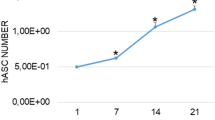Abstract
Multipotent adult progenitor cells (MAPCs) are bone marrow-derived stem cells with a high growth rate suitable for therapeutical applications as three-dimensional (3D) aggregates. Combined applications of osteogenically differentiated MAPC (OD-MAPC) aggregates and adeno-associated viral vectors (AAV) in bone bioengineering are still deferred until information with regard to expansion technologies, osteogenic potential, and AAV cytotoxicity and transduction efficiency is better understood. In this study, we tested whether self-complementary AAV (scAAV) can potentially be used as a gene delivery system in an OD-MAPC-based ‘in vivo’ bone formation model in the craniofacial region. Both expansion of rat MAPC (rMAPC) and osteogenic differentiation with dexamethasone were also tested in 3D aggregate culture systems ‘in vitro’ and ‘vivo’. rMAPCs grew as undifferentiated aggregates for 4 days, with a population doubling time of 37 h. After expansion, constant levels of Oct4 transcripts, and Oct4 and CD31 surface markers were observed, which constitute a hallmark of undifferentiated stage of rMAPCs. Dexamethasone effectively mediated rMAPC osteogenic differentiation by inducing the formation of a mineralized collagen type I network, and facilitated the activation of the wnt/β-catenin, a crucial pathway in skeletal development. To investigate the genetic modification of rMAPCs grown as 3D aggregates before implantation, scAAV serotypes 2, 3 and 6 were evaluated. scAAV6 packaged with the enhanced green fluorescent protein expression cassette efficiently mediated long-term transduction (10 days) ‘in vitro’ and ‘vivo’. The reporter transduction event allowed the tracing of OD-rMAPC (induced by dexamethasone) aggregates following OD-rMAPC transfer into a macro-porous hydroxyapatite scaffold implanted in a rat calvaria model. Furthermore, the scAAV6-transduced OD-rMAPCs generated a bone-like matrix with a collagenous matrix rich in bone-specific proteins (osteocalcin and osteopontin) in the scaffold macro-pores 10 days post-implantation. Newly formed bone was also observed in the interface between native bone and scaffold. The collective work supports future bone tissue engineering applications of 3D MAPC cultures for expansion, bone formation and the ability to alter genetically these cells using scAAV vectors.
This is a preview of subscription content, access via your institution
Access options
Subscribe to this journal
Receive 6 print issues and online access
$259.00 per year
only $43.17 per issue
Buy this article
- Purchase on SpringerLink
- Instant access to full article PDF
Prices may be subject to local taxes which are calculated during checkout








Similar content being viewed by others
References
Ulloa-Montoya F, Kidder BL, Pauwelyn KA, Chase LG, Luttun A, Crabbe A et al. Comparative transcriptome analysis of embryonic and adult stem cells with extended and limited differentiation capacity. Genome Biol 2007; 8: R163.
Roobrouck VD, Clavel C, Jacobs SA, Ulloa-Montoya F, Crippa S, Sohni A et al. Differentiation potential of human postnatal mesenchymal stem cells, mesoangioblasts, and multipotent adult progenitor cells reflected in their transcriptome and partially influenced by the culture conditions. Stem Cells 2011; 29: 871–882.
Subramanian K, Park Y, Verfaillie CM, Hu WS . Scalable expansion of multipotent adult progenitor cells as three-dimensional cell aggregates. Biotechnol Bioeng 2011; 108: 364–375.
Taiani JT, Krawetz RJ, Zur Nieden NI, Elizabeth Wu Y, Kallos MS, Matyas JR et al. Reduced differentiation efficiency of murine embryonic stem cells in stirred suspension bioreactors. Stem Cells Dev 2010; 19: 989–998.
Hong L, Sultana H, Paulius K, Zhang G . Steroid regulation of proliferation and osteogenic differentiation of bone marrow stromal cells: a gender difference. J Steroid Biochem Mol Biol 2009; 114: 180–185.
zur Nieden NI, Kempka G, Rancourt DE, Ahr HJ . Induction of chondro-, osteo- and adipogenesis in embryonic stem cells by bone morphogenetic protein-2: effect of cofactors on differentiating lineages. BMC Dev Biol 2005; 5: 1–15.
Arpornmaeklong P, Brown SE, Wang Z, Krebsbach PH . Phenotypic characterization, osteoblastic differentiation, and bone regeneration capacity of human embryonic stem cell-derived mesenchymal stem cells. Stem Cells Dev 2009; 18: 955–968.
Yazici C, Takahata M, Reynolds DG, Xie C, Samulski RJ, Samulski J et al. Self-complementary AAV25-BMP2-coated femoral allografts mediated superior bone healing versus live autografts in mice with equivalent biomechanics to unfractured femur. Mol Ther 2011; 19: 1416–1425.
McCarty DM, Fu H, Monahan PE, Toulson CE, Naik P, Samulski RJ . Adeno-associated virus terminal repeat (TR) mutant generates self-complementary vectors to overcome the rate-limiting step to transduction ‘in vivo’. Gene Therapy 2003; 10: 2112–2118.
Gao R, Yan X, Zheng C, Goldsmith CM, Afione S, Hai B et al. AAV2-mediated transfer of the human aquaporin-1 cDNA restores fluid secretion from irradiated miniature pig parotid glands. Gene Therapy 2011; 18: 38–42.
Chng K, Larsen SR, Zhou S, Wright JF, Martiniello-Wilks R, Rasko JE . Specific adeno-associated virus serotypes facilitate efficient gene transfer into human and non-human primate mesenchymal stromal cells. J Gene Med 2007; 9: 22–32.
Stender S, Murphy M, O’Brien T, Stengaard C, Ulrich-Vinther M, Soballe K et al. Adeno-associated viral vector transduction of human mesenchymal stem cells. Eur Cell Mater 2007; 13: 93–99; discussion 99.
Montes GS, Junqueira LC . The use of the Picrosirius-polarization method for the study of the biopathology of collagen. Mem Inst Oswaldo Cruz 1991; 86 (Suppl 3): 1–11.
Triffitt JT . Osteogenic stem cells and orthopedic engineering: summary and update. J Biomed Mater Res 2002; 63: 384–389.
Mauney JR, Volloch V, Kaplan DL . Role of adult mesenchymal stem cells in bone tissue engineering applications: current status and future prospects. Tissue Eng 2005; 11: 787–802.
Kulterer B, Friedl G, Jandrositz A, Sanchez-Cabo F, Prokesch A, Paar C et al. Gene expression profiling of human mesenchymal stem cells derived from bone marrow during expansion and osteoblast differentiation. BMC Genomics 2007; 8: 70.
Ji KH, Xiong J, Fan LX, Hu KM, Liu HQ . Rat marrow-derived multipotent adult progenitor cells differentiate into skin epidermal cells ‘in vivo’. J Dermatol 2009; 36: 403–409.
Dimomeletis I, Deindl E, Zaruba M, Groebner M, Zahler S, Laslo SM et al. Assessment of human MAPCs for stem cell transplantation and cardiac regeneration after myocardial infarction in SCID mice. Exp Hematol 2010; 38: 1105–1114.
Kehoe DE, Jing D, Lock LT, Tzanakakis ES . Scalable stirred-suspension bioreactor culture of human pluripotent stem cells. Tissue Eng Part A 2010; 16: 405–421.
King JA, Miller WM . Bioreactor development for stem cell expansion and controlled differentiation. Curr Opin Chem Biol 2007; 11: 394–398.
Buzzard JJ, Gough NM, Crook JM, Colman A . Karyotype of human ES cells during extended culture. Nat Biotechnol 2004; 22: 381–382; author reply 382.
Maitra A, Arking DE, Shivapurkar N, Ikeda M, Stastny V, Kassauei K et al. Genomic alterations in cultured human embryonic stem cells. Nat Genet 2005; 37: 1099–1103.
Draper JS, Smith K, Gokhale P, Moore HD, Maltby E, Johnson J et al. Recurrent gain of chromosomes 17q and 12 in cultured human embryonic stem cells. Nat Biotechnol 2004; 22: 53–54.
Bonewald LF, Harris SE, Rosser J, Dallas MR, Dallas SL, Camacho NP et al. von Kossa staining alone is not sufficient to confirm that mineralization in vitro represents bone formation. Calcif Tissue Int 2003; 72: 537–547.
Declercq HA, Verbeeck RM, De Ridder LI, Schacht EH, Cornelissen MJ . Calcification as an indicator of osteoinductive capacity of biomaterials in osteoblastic cell cultures. Biomaterials 2005; 26: 4964–4974.
Boyden LM, Mao J, Belsky J, Mitzner L, Farhi A, Mitnick MA et al. High bone density due to a mutation in LDL-receptor-related protein 5. N Engl J Med 2002; 346: 1513–1521.
Etheridge SL, Spencer GJ, Heath DJ, Genever PG . Expression profiling and functional analysis of Wnt signaling mechanisms in mesenchymal stem cells. Stem Cells 2004; 22: 849–860.
Gong Y, Slee RB, Fukai N, Rawadi G, Roman-Roman S, Reginato AM et al. LDL receptor-related protein 5 (LRP5) affects bone accrual and eye development. Cell 2001; 107: 513–523.
Angers S, Moon RT . Proximal events in Wnt signal transduction. Nat Rev Mol Cell Biol 2009; 10: 468–477.
zur Nieden NI, Price FD, Davis LA, Everitt RE, Rancourt DE . Gene profiling on mixed embryonic stem cell populations reveals a biphasic role for beta-catenin in osteogenic differentiation. Mol Endocrinol 2007; 21: 674–685.
Hughes K, Nikolakaki E, Plyte SE, Totty NF, Woodgett JR . Modulation of the glycogen synthase kinase-3 family by tyrosine phosphorylation. EMBO J 1993; 12: 803–808.
Wang QM, Fiol CJ, DePaoli-Roach AA, Roach PJ . Glycogen synthase kinase-3 beta is a dual specificity kinase differentially regulated by tyrosine and serine/threonine phosphorylation. J Biol Chem 1994; 269: 14566–14574.
Case N, Rubin J . Beta-catenin—a supporting role in the skeleton. J Cell Biochem 2010; 110: 545–553.
Lochhead PA, Kinstrie R, Sibbet G, Rawjee T, Morrice N, Cleghon V . A chaperone-dependent GSK3beta transitional intermediate mediates activation-loop autophosphorylation. Mol Cell 2006; 24: 627–633.
Itasaki N, Hoppler S . Crosstalk between Wnt and bone morphogenic protein signaling: a turbulent relationship. Dev Dyn 2010; 239: 16–33.
Zhang M, Yan Y, Lim YB, Tang D, Xie R, Chen A et al. BMP-2 modulates beta-catenin signaling through stimulation of Lrp5 expression and inhibition of beta-TrCP expression in osteoblasts. J Cell Biochem 2009; 108: 896–905.
Nakashima A, Katagiri T, Tamura M . Cross-talk between Wnt and bone morphogenetic protein 2 (BMP-2) signaling in differentiation pathway of C2C12 myoblasts. J Biol Chem 2005; 280: 37660–37668.
Hai B, Yan X, Voutetakis A, Zheng C, Cotrim AP, Shan Z et al. Long-term transduction of miniature pig parotid glands using serotype 2 adeno-associated viral vectors. J Gene Med 2009; 11: 506–514.
Lebherz C, Auricchio A, Maguire AM, Rivera VM, Tang W, Grant RL et al. Long-term inducible gene expression in the eye via adeno-associated virus gene transfer in nonhuman primates. Hum Gene Ther 2005; 16: 178–186.
Podsakoff G, Wong Jr KK, Chatterjee S . Efficient gene transfer into nondividing cells by adeno-associated virus-based vectors. J Virol 1994; 68: 5656–5666.
Han Z, Zhong L, Maina N, Hu Z, Li X, Chouthai NS et al. Stable integration of recombinant adeno-associated virus vector genomes after transduction of murine hematopoietic stem cells. Hum Gene Ther 2008; 19: 267–278.
Subramanian K, Geraerts M, Pauwelyn KA, Park Y, Owens DJ, Muijtjens M et al. Isolation procedure and characterization of multipotent adult progenitor cells from rat bone marrow. Methods Mol Biol 2010; 636: 55–78.
Reyes M, Lund T, Lenvik T, Aguiar D, Koodie L, Verfaillie CM . Purification and ex vivo expansion of postnatal human marrow mesodermal progenitor cells. Blood 2001; 98: 2615–2625.
Ng ES, Davis RP, Azzola L, Stanley EG, Elefanty AG . Forced aggregation of defined numbers of human embryonic stem cells into embryoid bodies fosters robust, reproducible hematopoietic differentiation. Blood 2005; 106: 1601–1603.
Grieger JC, Choi VW, Samulski RJ . Production and characterization of adeno-associated viral vectors. Nat Protoc 2006; 1: 1412–1428.
Chang MC, Ko CC, Douglas WH . Preparation of hydroxyapatite–gelatin nanocomposite. Biomaterials 2003; 24: 2853–2862.
Kasper FK, Young S, Tanahashi K, Barry MA, Tabata Y, Jansen JA et al. Evaluation of bone regeneration by DNA release from composites of oligo(poly(ethylene glycol) fumarate) and cationized gelatin microspheres in a critical-sized calvarial defect. J Biomed Mater Res A 2006; 78: 335–342.
Acknowledgements
We thank Sandra Horton at North Carolina State University for processing ‘in vivo’ tissue specimens for immunohistochemistry and Victoria Madden at UNC Microscopy Services Laboratory for processing in vitro cell matrices for electron microscopy. Also, we would like to acknowledge Dr Ganokon Urkasemsin for her contribution towards the statistical analysis of this project. João Ferreira was supported by the doctoral fellowship of FCT-Portuguese Foundation for Science and Technology (SFRH/BD/36841/2007). This work was supported in part by grants from the: NIH/NIDCR (K08DE018695), NC Biotech Center, American Association for Orthodontist Foundation awarded to C-CK; Northwest Genome Engineering Consortium pilot awarded to MLH; and Wellstone (5U54AR056953) and NIH (5R01AI072176) awarded to RJS.
Author information
Authors and Affiliations
Corresponding author
Ethics declarations
Competing interests
The authors declare no conflict of interest.
Additional information
Supplementary Information accompanies the paper on Gene Therapy website
Rights and permissions
About this article
Cite this article
Ferreira, J., Hirsch, M., Zhang, L. et al. Three-dimensional multipotent progenitor cell aggregates for expansion, osteogenic differentiation and ‘in vivo’ tracing with AAV vector serotype 6. Gene Ther 20, 158–168 (2013). https://doi.org/10.1038/gt.2012.16
Received:
Revised:
Accepted:
Published:
Issue date:
DOI: https://doi.org/10.1038/gt.2012.16
Keywords
This article is cited by
-
A comparison of radiographic and clinical outcomes of anterior lumbar interbody fusion performed with either a cellular bone allograft containing multipotent adult progenitor cells or recombinant human bone morphogenetic protein-2
Journal of Orthopaedic Surgery and Research (2017)
-
In-situ hybridization of calcium silicate and hydroxyapatite-gelatin nanocomposites enhances physical property and in vitro osteogenesis
Journal of Materials Science: Materials in Medicine (2015)



